Hello again! We’re back with a review of the data from Roman Northants; thanks again to my assistant Katie Robbins for all her backgound research.
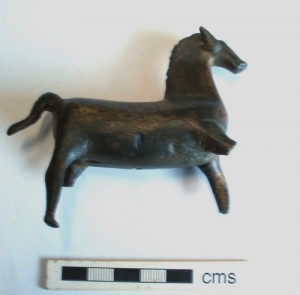
Roman Horse Figurine
During the Roman period (traditionally dated AD 43-410), Northamptonshire sees considerable expansion in several areas of life and commerce, including the intensification of agricultural production, the establishment of craft and industry, the construction of road networks and the foundation of market settlements and religious centres.
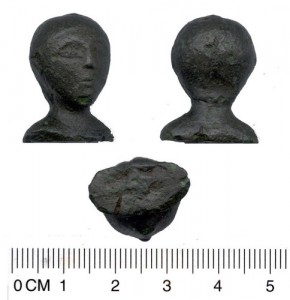
Roman figurative bust
Small towns developed at Towcester, Titchmarsh, Kettering and Duston, all bound together by the expansive Roman road network. The identification of earlier settlement activity at many of these locations suggests that these Roman roads often followed the routes of prehistoric pathways (another issue that controlled and targetted detecting and reporting might help to address). Other nucleated settlements were scattered throughout the county, and rural settlement in particular shows interesting patterning. Many ‘non-villa’ rural settlements seem to have been abandoned or transformed with the coming of the Romans, perhaps reconstructed in rectilinear forms around trackways and ditched enclosures. For example, in in the north-east of the county, the 2nd century saw the replacement of Iron Age round houses by aisled buildings and villas. However, in central and south Northamptonshire, these typically Iron Age constructions continued to develop alongside the newly introduced row-type villas. This distinction raises important questions about the nature of settlement and identity in different parts of the county; are we seeing discrete local political situations and identities? And could metal detected finds help to clarify what was going on?
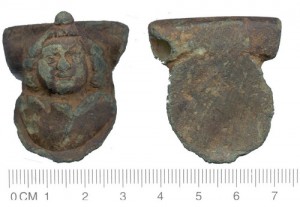
Roman vessel mount
Whatever the explanation of this local variation, villas are fairly well known right across the county, though there is considerable variation in morphology. Building types range from large, complex constructions to much smaller, simpler affairs. Agriculture, trade and industry blossomed in Romano-British Northants, and this is again an area in which detected finds might be informative. In addition to more traditional crop farming, there is evidence for grape-growing (presumably for wine), while the local ceramic and quarry-stone industries were also important. However, perhaps most notable is the importance of the iron industry, and parts of the county may have been reponsible for extraction of much of the ore required to run the regional and military economies of Roman Britain.
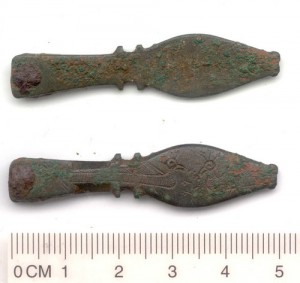
Roman amphora strapend
Moving away from the practicalities of day-to-day living, we also know alittle about the beliefs of the inhabitants of Roman-British Northants. A number of possible religious sites have been identified, and detected finds such as figurines, votive axes, or objects bearing Christian iconography (such as the Chi-Ro symbol) might be clues as to the presence of such shrines or temple sites.
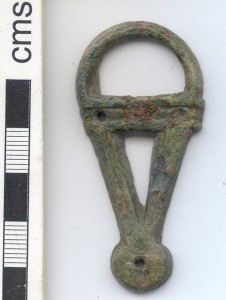
Late Roman buckle and openwork plate
In short, Roman Northants is probably better understood than its prehistoric counterpart. We know of a number of towns in the county, and archaeology – in some cases undertaken with the co-operation of metal detectorists – is helping us to answer a lot of important social and economic questions. However, the countryside is more poorly understood; we have lots of villas and small settlements in the county, but what was going on between these sites, and how were people moving though the landscape? Obviously the major roads like Watling Street played an important role, but surely there were many smaller trackways and meeting points that we don’t know about. Conceivably, metal detected finds, when properly provenanced with findspot details, can help us to identify some of these sites.
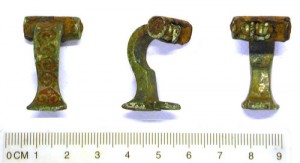
A Roman Enameled Knee Brooch
A good example of this is provided by the data that came out of last year’s rally at Islip – more on that later if I get around to it! In the meantime, here’s a quick run through of some of the most exciting finds we’ve had.
We’ve had lots of Roman finds from the county; they are far and away the most numerous of all the things I see. Unusual decorative items include this unusual (presumably ritually depsoited ) equestrian figurine from Brigstock [NARC-81AAB5], this bust (which may perhaps be the anthopomorphic butt of a knife handle) from Nether Heyford [NARC-E6A001], and this mount [NARC-9BBD94] from Titchmarsh. The precise functions of all are unclear, but both display asethetic qualities and are suggestive of specialised manufacture. Dress accessories such as brooches are more commonly found; nice examples include this enamelled knee brooch [NARC-96E378] from Norton, this ‘amphora-shaped’ strapend from Moulton [NARC-DF98F1], and this lovely late Roman military buckle from Hinton-in-the-Hedges [NARC-C6E5B8].
However, perhaps the star of the last few years is this rather unassuming nail cleaner from the Daventry area, which thus far is unparalleled anywhere in Europe [NARC-733D28].
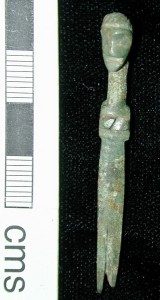
Unusual Anthropomorphic Nail Cleaner
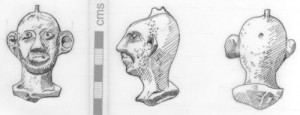
There was also an amazingly intricately cast steelyard weight [NARC-8D6343] from Paulerspury, which, together with a number of similar (if less ornate) PAS finds, and artefacts from excavations as several villa sites around the county, stands as testament to the importance of trade in the region.
On the subject of trade, let’s not forget the coins. Quite apart from all the ‘grot’ (as the number of Roman coins from Northants to date stands at 3351 records, it is really starting to provide an invaluable resource for understanding economy and settlement in Roman Northamptonshire), we’ve had one or two coins that are notable in aesthetic and numismatic terms, including unusual nummi ([NARC-8CF536] and [NARC-78D771]), and rare silver denarii of Marc Antony [NARC-E2D310] and Antoninus Pius [NARC-A3E503].
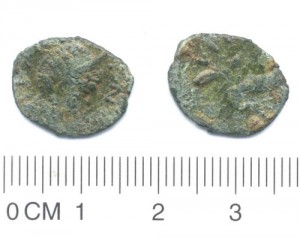
Recently, we had this unusual barbarous coin, copying a radiate of Salonina (wife of Gallienus). There is only one coin like this in the entire Cunetio hoard! It might not look like much to most of us, but Sam, the PAS’s coin guru at the BM, picked it out. So please don’t forget to show us your grot! Bring it in, bring it in, bring it in!